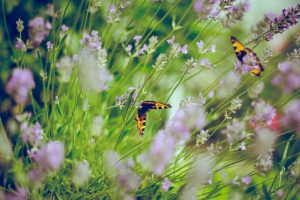There’s nothing quite like the first signs of spring when crocus and daffodils start poking out of the ground after a long winter. If this is a sight you’d like to see in your garden, now is the time to plant bulbs.
Most flowers that people associate with spring start as bulbs and need to be planted in the fall before winter begins. The cold period over the winter is important to the growth of the flower. This process is called vernalization.
Vernalization: During a cold period, plants acquire the ability to bloom, but they may require additional seasonal cues or weeks of growth before they will actually flower.
We recently received a huge shipment of bulbs. There are so many varieties and colors to choose from, you can grow a rainbow in your garden! Erica, one of our plant knowledge pros, broke it down and shared some fun facts plus things to be on the lookout for as you select and plant your bulbs this fall.
a
 6 Bulb Planting Tips
6 Bulb Planting Tips
1. Spring bulbs have different blooming times, which you can find on the packaging labels. They typically flower in early-spring, mid-spring, or late spring. When you select your bulbs, try to stagger the bloom times so you have color for the whole season. (Hint: Most mixed bulb bags take this into consideration and will include a variety of bloom times)
2. Always check the label for the suggested planting depth. You’ll also be able to find information about how far to space apart each bulb. If the bulb is planted too deep or too shallow, it’s possible it won’t flower at all.
3. For a strong bloom, mix in a Bulb Specific fertilizer at the bottom of your hole. That way when the roots develop, there will be nutrients immediately available.
Fun Fact:
 Do you know why you sometimes see Daffodils called Narcissus? Narcissus is the genus name for Daffodils. In Greek mythology, the character Narcissus falls in love with his own reflection in a pool of water and spends a lifetime bent over staring at himself.
Do you know why you sometimes see Daffodils called Narcissus? Narcissus is the genus name for Daffodils. In Greek mythology, the character Narcissus falls in love with his own reflection in a pool of water and spends a lifetime bent over staring at himself.
Much like the position of Narcissus, the trumpet of the Daffodil pulls the flower forward as if it is looking down. That’s how it got its genus name!
4. Erica recommends digging a trench to the correct planting depth for the entire space you choose to plant your bulbs. Space your bulbs apart and cover the trench back up with dirt. If you’d rather dig one hole at a time, there are a few tools to choose from:
5. Bulbs look more natural planted in groupings of odd numbers, rather than in straight lines. Because large areas of color are more attractive to the eye, plant your bulbs in clusters.
6. If you’re a nervous, first-time bulb planter, rest assured. It’s practically foolproof. Just make sure to follow the directions on the package’s label for planting depth and the orientation of the bulb. Basically, make sure the root side is down and the pointy side is up!
Want a fun and festive garden for the Fourth of July?
Plant Allium bulbs now!
When they bloom in the spring, you will be able to enjoy their beautiful purple bloom. The plant will stiffen as they start to brown and you can spray paint them red, white, and blue (or any color you want!) for a patriotic display come summer. They are also great cut flowers for an indoor arrangement in your favorite vase.



